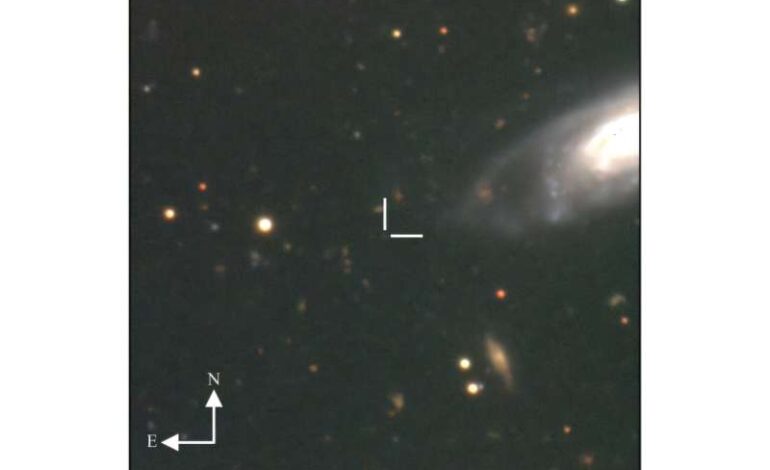Astronomers Uncover Origins of Distant Type Ibn Supernova SN 2024acyl

An international team of astronomers has conducted an extensive observational study of a distant Type Ibn supernova named SN 2024acyl. The findings, published on November 6, 2025, on the arXiv preprint server, provide new insights into the properties and potential origins of this celestial explosion.
Type Ibn supernovae are characterized by low-velocity helium emission lines and are believed to result from the core-collapse of massive stars. These explosions typically exhibit high peak luminosities and a blue appearance at their peak brightness. Observations indicate that Type Ibn supernovae evolve quickly, with a rapid rise to peak brightness in less than two weeks, followed by a swift decline.
Discovered on December 1, 2024, by the Asteroid Terrestrial-Impact Last Alert System (ATLAS), SN 2024acyl is located approximately 398 million light years from Earth. Its unusual position, about 114,000 light years away from its host galaxy, raises questions regarding its formation and evolutionary history.
Observations and Findings
Led by Yize Dong of the Harvard-Smithsonian Center for Astrophysics (CfA), the research team initiated multi-band photometric follow-up observations primarily using the Las Cumbres Observatory Global Telescope Network, alongside other ground-based facilities. The aim was to investigate the unusual offset of SN 2024acyl from its host galaxy and delve deeper into its characteristics.
The study confirmed that SN 2024acyl possesses the typical photometric and spectroscopic features associated with Type Ibn supernovae. Its redshift, measured at approximately 0.027, aligns with that of the nearby galaxy CGCG 505-052, indicating a strong likelihood of association. Notably, the star formation rate at the explosion site of SN 2024acyl was found to be low, which, combined with its significant distance from the host, presents an anomaly for typical massive star origins.
Implications of the Research
Astronomers noted that SN 2024acyl is situated around 32,500 light years from the nearest substantial light source of its host galaxy. This distance raises the possibility that the progenitor star may have been a runaway star, ejected from its birthplace due to close encounters in a dense stellar cluster or as a result of the supernova explosion of a companion star in a binary system.
The research team emphasized the diversity present within the known population of Type Ibn supernovae. The variations in host environments and spectral properties suggest the potential existence of multiple progenitor channels for these supernovae.
The findings of this study contribute significantly to the understanding of Type Ibn supernovae and their origins, challenging existing paradigms regarding their formation. The full implications of these observations may broaden the scope of research into the life cycles of massive stars and their explosive deaths.
As the scientific community continues to explore these celestial phenomena, the research highlights the complexities of stellar evolution and the dynamic processes that govern our universe. The work conducted by Dong and his colleagues marks an important step in unraveling the mysteries of supernovae and their diverse characteristics.






